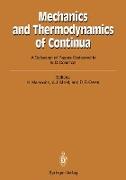Mechanics and Thermodynamics of Continua
BücherAngebote / Angebote:
by Noll, then scantly known, at the Carnegie Institute of Technology. An invita tional meeting on visco-elasticity in the following April at Lancaster, Pennsyl vania, brought Coleman and Noll together. In those days a person went to a meet ing so as to learn from a few competent lectures without having to be himself one more "invited speaker" or to listen to many multiples of ten minutes of trivial trash. Ericksen lectured on "laminar shear flows" of incompressible, Rivlin-Erick sen fluids. That class of flows contains all those for which Rivlin and others had obtained exact solutions. Ericksen's paper, with Criminale & Filbey as co-authors, was to appear soon in Volume 1 of the Archive. At the meeting, Coleman and Noll found that they had similar views on thermodynamics. The rheologists there, like those we had encountered elsewhere, told us that classical thermodynamics was a complete, closed, perfect science, all in Gibbs's paper, and they laughed at us. We laughed at them, but silently, for we had read fundamental parts of Gibbs's work, especially that on the isothermal and isentropic theories of three-dimensional elasticity, which, surely, the rheologists could not understand. We knew also the basic inequality for increase of entropy asserted by Duhem (1901) and in "The Mechanical Foundations" (1952) called "the Clausius-Duhem inequality" (Eq. (28. 5», from which Eckart (1940) had drawn consequences by guessing the signs oftwo terms ("Mechanical Foundations", text following Eq. (31. 1».
Folgt in ca. 5 Arbeitstagen
